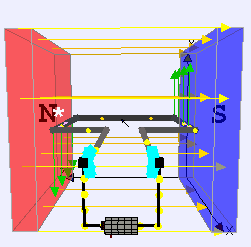HUMAN EYE –
ACCOMMODATION
A human eye with normal vision can see nearby objects as close as 25cm clearly and distinctly and far away objects as far as infinity clearly without any strain in eyes.
To see an object clearly the eye lens must focus the image on the retina. This sharp focusing is achieved by eye lens with the help of ciliary muscles. The ability of eye lens to adjust its focal length to focus objects at different distances on the retina is called accommodation.
How Accommodation is achieved?
An eye lens is a jelly like material made up of protein. The curvature/shape of the eye lens can be changed to some extent by the action of ciliary muscles. When ciliary muscles contract, curvature of eye lens increases. This decreases focal length of eye lens. This enables us to see nearby objects clearly.
Similarly when ciliary muscles relax, curvature of eye lens decreases. This increases focal length of eye lens. This enables us to see far away objects clearly.
The following steps would be easier to understand the process.
To view nearby objects:
Ciliary muscles contracts → curvature of eye lens increases → eye lens becomes thicker → focal length of eye lens decreases → image of nearby objects focused on the retina
The above action of ciliary muscles and eye lens enables us to see nearby objects clearly.
To view far away objects:
Ciliary muscles relaxes in this situation → curvature of eye lens decreases → eye lens becomes thinner → focal length of eye lens decreases → image of far away objects focused on the retina.
The above action of ciliary muscles and eye lens enables us to see far objects clearly.
The power of accommodation for a normal vision is 4 dioptre.
The power of eye lens when a nearby objects is viewed is 44 D. The power of eye lens when a far away object is viewed is 40 D. Thus the maximum variation in the power of eye lens achieved is 44D – 40D = 4D.
Least distance of distinct vision (Near point)
The minimum distance at which the object can be see clearly and distinctly without any strain in the eyes is called the least distance of distinct vision or near point of the eye.
For a person with normal vision this value is 25 cm.
What would happen if the object is closer than 25 cm? Would any image be formed on eye lens?
Yes, the image would be formed but that will be blurred, not well focused. Try focusing on the object. Some of you may be able to focus the object but if would cause strain in your eye after few seconds.
Try holding a pen or a pencil close to your eye or nose. At first the object will appear blurred but if you try to focus object may get focused to some extent causing strain in your eye. You have to either shift your focus or have to move away the object from you.
Reason:
The curvature of the eye lens can be change up to some extent only and that with the help of cilicary muscles. Thus focal length of eye lens cannot be decreased beyond a certain minimum limit. Hence there is minimum distance at which objects can be seen comfortably. That minimum comfortable distance is 25 cm. This is called near point or least distance of distinct vision.
Far point
The farthest point up to which a human eye with normal vision can see is infinity and this is called the far point of human eye.
Try focusing a star. These stars are hundred, thousand light years from us. The nearest star Alpha centuri is 4.2 LY away. ( 1 LY = 9.46 X \(10^{15}\) m)











